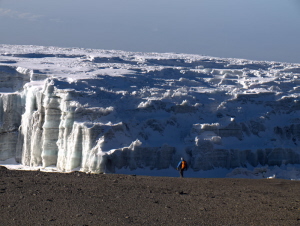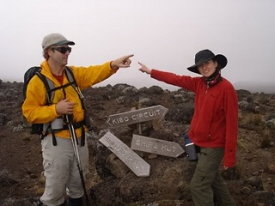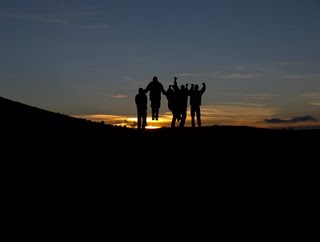Kilimanjaro as a Metaphor for Life
Story and Photos by Richard Wiese
Mt. Kilimanjaro has had a magical appeal for me ever since I climbed it as an eleven year old with my father, even though it was an awful experience. We did everything the wrong way. There were no training hikes to prepare us for the grueling physical challenges of the mountain and no guides to show us the most effective way to the summit. We didn’t bring enough water and our cotton clothing was completely inappropriate for both the tropical conditions at the mountain’s base and the frigid glacier at its highest elevations.

Still, we made it to the summit, 19,345 feet above the East African plain and the view from the top of Africa’s highest mountain is something I will never forget. Kilimanjaro was the first mountain I ever climbed and it ignited my lifelong interest in exploration.
Since that first climb, I’ve returned many times and have discovered that for those who try to climb Kili, the mountain is almost always a metaphor. You climb it not just to reach the summit, but to prove something to yourself. This was particularly true on one particular expedition, in January 2005, when I led three to the summit.
For Keech, Kili was a physical test. A year earlier, this athletic 27-year-old broke her neck in a skiing accident that nearly killed her. She spent weeks in the hospital and her doctors were uncertain if she would ever be able to walk again. Miraculously, she made a nearly complete recovery. But could she return to her pre-accident form? The mountain would give the answer.
For Alan, it offered a shot at redemption. A 55-year-old Wall Street trader, Alan had tried to climb Kilimanjaro in 1980 but ignored the warning of “pole, pole” (pronounced “poh-lay, poh-lay,” it means “slowly, slowly” in Swahili) and tried to reach the summit in a mere three days. Suffering from altitude sickness at 16,000 feet, he’d had to retreat to lower elevations.
For Kay, Kilimanjaro represented a new lease on life. A sophisticated New York woman, Kay  had admitted to me privately that she had not emerged from the funk that had engulfed her ever since her husband had passed away several years earlier. The idea of climbing Africa’s highest mountain seemed to light a fire inside her. had admitted to me privately that she had not emerged from the funk that had engulfed her ever since her husband had passed away several years earlier. The idea of climbing Africa’s highest mountain seemed to light a fire inside her.
As we set off for Tanzania, Kilimanjaro had unexpectedly become a metaphor for me, too. Bedridden with the flu for three weeks prior to departure, I had serious doubts about my own ability to lead a climb. Kili would be a test with the outcome very much in question.
A tropical rainforest circles Kilimanjaro at its base, so for most of our first day we hiked under a canopy of high trees, moss-coated vines and ferns. After nine hours, we emerged from the rain forest into a dryer, savannah-like part of the mountain, where we made camp for the night, just below 10,000 feet. Waiting for dinner in our small mess tent, everyone looked exhausted. Kay arrived much later than the others, looking pale and very weak. Privately, Keech and I worried whether she would be able to reach the summit.
Over the next two days, we experienced the wrath of Kili’s fast-changing weather as the sunshine turned to rain, slowing our pace and wreaking havoc on our fragile emotions.
But in general, Keech seemed to be doing well. Alan appeared strong and relaxed because he had learned “pole, pole” as his mountain mantra. Kay, on the other hand, though a dogged optimist, had been struggling. The climb was taking an unmistakable physical toll on her. And the most difficult part was still ahead.
After spending the night at our camp at Lava Tower, a two hundred foot column of of orange volcanic rock at 15,000 feet, we awoke to find our tents covered in ice-it had snowed throughout the night. This day would be an easy one, a short climb to 16,500 feet to our next camp, at Arrow Glacier, our introduction to the famous glaciers that cover the uppermost slopes of Kili. There, the sound of distant avalanches made everyone uneasy. Our party was experiencing the first real effects of high altitude: appetites had diminished, and several of us were suffering from headaches. famous glaciers that cover the uppermost slopes of Kili. There, the sound of distant avalanches made everyone uneasy. Our party was experiencing the first real effects of high altitude: appetites had diminished, and several of us were suffering from headaches.
As we awoke for our seventh day on the mountain, we all knew that the most difficult leg of the climb lay ahead. The Western Breach rises sharply up to the rim of Kilimanjaro’s volcanic crater, an intimidating scramble of rocky crags and steep drop offs. So we set off and slowly, winding our way up the steep path which was covered in ice.
The pace of the climb slowed and the group spread out. At lunch, we waited over an hour for Kay, but she never showed up. Knowing Jonas, my fellow guide, had dropped back to join her, we pressed on. Our normal chatter was reduced to breathing and grunting. After a series of false ridge tops, we emerged onto the flat terrain of Kili’s crater, 18,750 feet above sea level and resembling an arctic moonscape –accented by the huge, indigo-streaked glaciers to the west. Uhuru Peak, the highest point on the crater rim and the summit of Kili, was visible a mere 600 feet above us.
Keech and Alan arrived but at 5 p.m., there was still no sign of Kay. Then, an hour later, we were astonished to see her stumble up over the ridge, barely able to walk and completely spent. The most difficult part of the climb was behind us.
We awoke the next morning and left camp at 6, watching as the sun rose into a cloudless blue sky. The weather gods of Kili were smiling. For two hours we ascended a steep, winding trail, up a series of rocky switchbacks. No one spoke, and there was no resting on this last push to the summit. We finally emerged onto a slightly-graded plateau and crossed a few hundred yards to a modest wooden sign, which marked the highest point on the African continent. Success.

I looked at Keech and saw that tears of joy had welled up in her eyes. Exactly one year before she had had her devastating skiing accident. But here she was on the summit of Kili. Alan was simply ecstatic – a 25-year-old monkey was finally off his back. Kay was the last to arrive, staggering and exhausted. I told her to take in the view, smell the air, and remember the moment. It would be with her for the rest of her life.
I took in the view with her--the vast African plain stretching for hundreds of miles, Mount Meru to the west and beyond it, the Serengeti Plain. I glanced over at Keech quietly sobbing to herself, at Alan beaming and at Kay taking in the roof of Africa. For all of us, Kilimanjaro had become a mountain of dreams…fulfilled.
This year marks Richard’s 25th year of guiding and 40th year since his first ascent. His next mountain expedition is to Kilimanjaro, Tanzania October 30 – November 9, 2010, and is followed by an optional safari. For booking enquiries, please contact: Young Safaris, kilimanjaro@youngsafaris.com or 203-210-7777.
|
|
|

